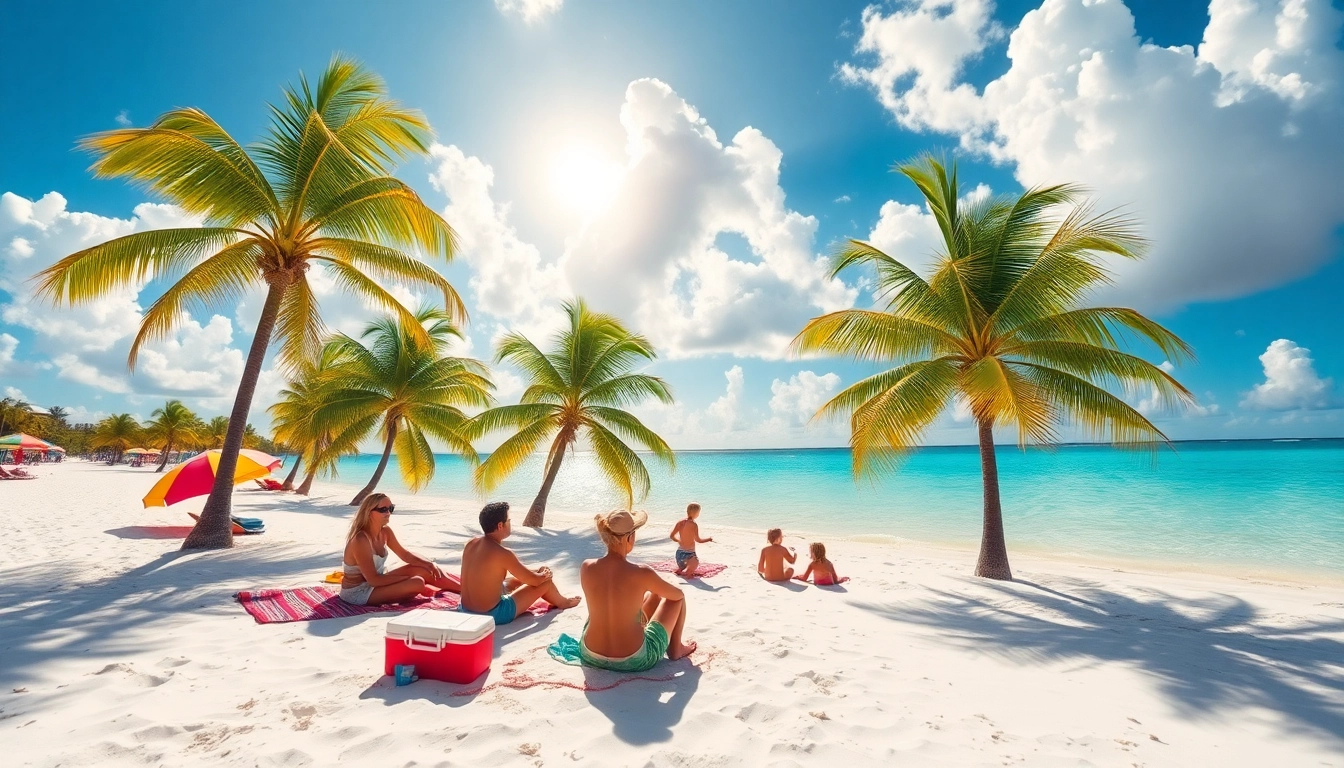Introduction to Snorkeling in Puerto Rico
Puerto Rico, a tropical paradise, is renowned for its stunning landscapes and vibrant marine ecosystems, making it a prime destination for snorkeling enthusiasts. With crystal-clear waters, colorful coral reefs, and a rich diversity of marine life, snorkel puerto rico offers unforgettable experiences for both beginners and seasoned snorkelers. In this article, we will explore the best locations for snorkeling in Puerto Rico, essential gear, marine ecosystems, and tips for planning your perfect adventure.
Overview of Snorkel Puerto Rico’s Best Locations
There are numerous snorkeling spots around Puerto Rico, each offering unique underwater experiences. Here are some of the best locations:
- Fajardo: The waters around Fajardo are famous for their vibrant coral reefs and abundant marine life. The nearby bioluminescent bay, Mosquito Bay, is also worth a visit.
- Culebra: This small island is home to some of the clearest waters in Puerto Rico. Flamenco Beach and the nearby Carlos Rosario Beach provide excellent snorkeling opportunities, boasting stunning coral reefs teeming with fish.
- Vieques: The island of Vieques is known for its pristine beaches and biodiverse ecosystems. Snorkeling at Mosquito Pier offers encounters with sea turtles and colorful fish.
- La Pared, Luquillo: A popular spot for locals, this beach provides a fantastic shoreline for snorkeling, where snorkelers can explore vibrant coral formations and schools of tropical fish.
- Guánica: The Guánica Dry Forest Reserve protects some of the coastline’s best-kept secrets. The waters here are clear, warm, and offer rich undersea landscapes.
Essential Gear for Snorkel Puerto Rico Adventures
When embarking on snorkeling adventures in Puerto Rico, having the right gear is crucial for both safety and enjoyment. Here is a list of essential snorkeling gear:
- Mask and Snorkel: A well-fitting mask and a quality snorkel are vital. Choose a mask with a comfortable seal to prevent water from entering and a snorkel that allows for easy breathing.
- Fins: Fins help you swim effortlessly. Opt for short fins for simplicity if you’re a beginner, while intermediate snorkelers might appreciate longer fins for more power.
- Wetsuit or Rash Guard: Depending on the water temperature, consider wearing a wetsuit or rash guard for protection against sunburn and jellyfish stings.
- Buoyancy Aid: Non-swimmers or novices should wear a life jacket or buoyancy aid for safety.
- Underwater Camera: To capture the beauty of your underwater adventures, an underwater camera is a great addition to your gear.
Understanding Marine Life and Ecosystems in Puerto Rico
Puerto Rico’s diverse marine ecosystems include coral reefs, seagrass beds, and mangroves, each hosting unique flora and fauna. Understanding these ecosystems enhances your snorkeling experience:
- Coral Reefs: These underwater structures support countless marine species. Common species you may encounter include parrotfish, angelfish, and sea turtles. Healthy reefs are vital for the marine ecosystem; they provide food and shelter to marine life.
- Seagrass Beds: Found in shallow waters, seagrass beds are nurseries for young fish species. You may also spot manatees grazing in these rich habitats.
- Mangroves: These coastal ecosystems serve as critical habitats for many species of fish and crustaceans. They are vital to the health of coastal waters and act as natural barriers against storms.
Planning Your Snorkeling Trip
Best Time of Year for Snorkel Puerto Rico Activities
Choosing the right time for your snorkeling trip can significantly enhance your experience. The ideal months for snorkeling in Puerto Rico are generally from December to April. These months feature warm water temperatures and clearer visibility due to lower rainfall. However, it’s essential to check local weather conditions and tide schedules, as these can impact visibility and safety.
Creating a Snorkeling Itinerary: What to Consider
A well-planned itinerary ensures you make the most out of your snorkeling trip. Consider the following factors:
- Duration: Plan how long you want to spend snorkeling each day. An average snorkeling session lasts 2-4 hours but can be adjusted based on your comfort and skill level.
- Location: Choose snorkel spots that align with your interests. If you’re keen on seeing sea turtles, research where they are commonly spotted.
- Groups: Depending on your preference, you can snorkel solo, with friends, or as part of a guided tour. Group tours often come with the benefit of expert guidance.
- Access and Amenities: Consider access to each site, including facilities like restrooms, equipment rentals, and parking.
Safety Tips When Snorkeling in Puerto Rico
Snorkeling, while exhilarating, comes with its set of challenges. To ensure a safe experience, keep these safety tips in mind:
- Buddy System: Always snorkel with a partner. This strategy enhances safety as you can keep an eye on each other.
- Understand Your Surroundings: Be aware of current conditions, tides, and local wildlife. Avoid touching or stepping on coral reefs, as they are delicate ecosystems.
- Stay Hydrated: Do not forget to drink plenty of water before and after your snorkeling sessions to keep your body well-hydrated.
- Watch for Boats: Stay aware of boating lanes and always keep a lookout for vessels while in the water.
Snorkeling Techniques for Beginners
Basic Snorkeling Skills: A Step-by-Step Guide
For those new to snorkeling, mastering essential skills is key to enjoying your underwater adventures. Here’s a step-by-step guide:
- Getting Comfortable: Before entering the water, practice breathing through the snorkel while standing or sitting on the shore.
- Entry Technique: Enter the water slowly, either from the shore or a boat. If entry is from the boat, shuffle backward off the edge.
- Breath Control: Focus on slow, steady breaths. Panic can cause you to hyperventilate, leading to water inhalation.
- Floating Technique: Use a relaxed and horizontal position in the water. Keep your body low to minimize drag as you swim.
- Fin Kicking: Use a gentle flutter kick to propel yourself forward. Avoid creating large splashes that could scare away marine life.
Understanding Breath Control Underwater
Controlling your breath while snorkeling is essential for both comfort and safety. Here are tips for effective breath control:
- Breath Slowly: Inhale deeply through your mouth, allowing your diaphragm to expand. Exhale slowly and completely through the snorkel.
- Panic Management: If you feel anxious, focus on your breath. Count your breaths to help maintain a relaxed state.
- Practice Holding Your Breath: Start by practicing in shallow waters. Gradually increase the time you can hold your breath as you become more comfortable.
How to Navigate Coral Reefs Safely
Navigating coral reefs safely while snorkeling is crucial, as these ecosystems are fragile and vital to marine life. Here are some tips:
- Avoid Touching Coral: Use your fins to propel yourself rather than your hands or body, which can accidentally damage coral.
- Be Aware of Your Surroundings: Stay alert for currents and underwater obstacles while snorkeling. Keep an eye on the distance between you and your snorkeling partner.
- Learn About Local Rules: Some areas may have specific guidelines or restrictions in place for preserving marine habitats.
Enhancing Your Snorkeling Experience
Top Accessories for Snorkel Puerto Rico Trips
To elevate your snorkeling experience further, consider adding the following accessories to your gear:
- Anti-Fog Spray: Apply anti-fog spray to your mask to maintain clear visibility throughout your session.
- Snorkeling Vest: A buoyancy vest enhances safety, especially for beginner snorkelers who may feel uneasy in deep water.
- Snorkel Bag: A waterproof backpack or bag will help keep your belongings dry and organized while at the beach.
Photography Tips for Capturing Underwater Moments
Capturing your underwater adventures can create lasting memories. Here are tips for taking stunning underwater photographs:
- Use a Waterproof Camera: Ensure your camera is rated for underwater use. Consider investing in a dedicated underwater camera for optimal results.
- Adjust Your Settings: Use settings that accommodate low light and fast-moving subjects. A higher ISO and faster shutter speed can help capture vibrant images.
- Stay Steady: To avoid blurry pictures, stabilize your camera against a solid object or use a floating wrist strap.
- Focus on Composition: Pay attention to framing and composition. Fill the frame with your subject while leaving some space for ambiance.
Sharing Your Experiences: Social Media Tips
Social media is an excellent platform for sharing your underwater adventures. Here are some tips for sharing:
- Use Relevant Hashtags: To gain visibility, use hashtags related to snorkeling, marine conservation, and your specific locations.
- Engage with the Community: Connect with fellow snorkelers by commenting on and sharing their experiences. Building a community can enhance your snorkeling journey.
- Tell a Story: Share your snorkeling story and what you experienced. Authentic storytelling resonates well with followers.
Contributing to Marine Conservation
The Importance of Protecting Puerto Rico’s Marine Ecosystems
Snorkelers play a vital role in protecting marine ecosystems. Healthy marine environments enhance our snorkeling experiences and support biodiversity and ecological balance. Coral reefs are among the most valuable ecosystems, providing habitat for countless marine species and offering critical protection against coastal erosion.
How Snorkelers Can Help Preserve Marine Life
As you explore Puerto Rico’s underwater landscapes, consider these practices to contribute to the preservation of marine life:
- Practice Responsible Snorkeling: Stick to designated pathways and avoid stepping on or touching coral. Respect wildlife by maintaining a safe distance.
- Participate in Clean-Up Efforts: Join or organize beach and underwater clean-up events to help keep marine environments free from debris.
- Educate Others: Share your knowledge about marine ecosystems and the importance of conservation with fellow snorkelers and tourists.
Organizations to Support for Marine Conservation
Several organizations work tirelessly to protect marine ecosystems in Puerto Rico. Consider supporting initiatives such as:
- Coral Triangle Initiative: Focused on promoting sustainable coral reef management, this organization plays a vital role in marine conservation.
- Ocean Conservancy: This organization strives to protect ocean ecosystems while addressing pressing issues such as plastic pollution.
- ReefBase: A comprehensive database dedicated to coral reef management and research, offering vital resources for marine conservation efforts.



